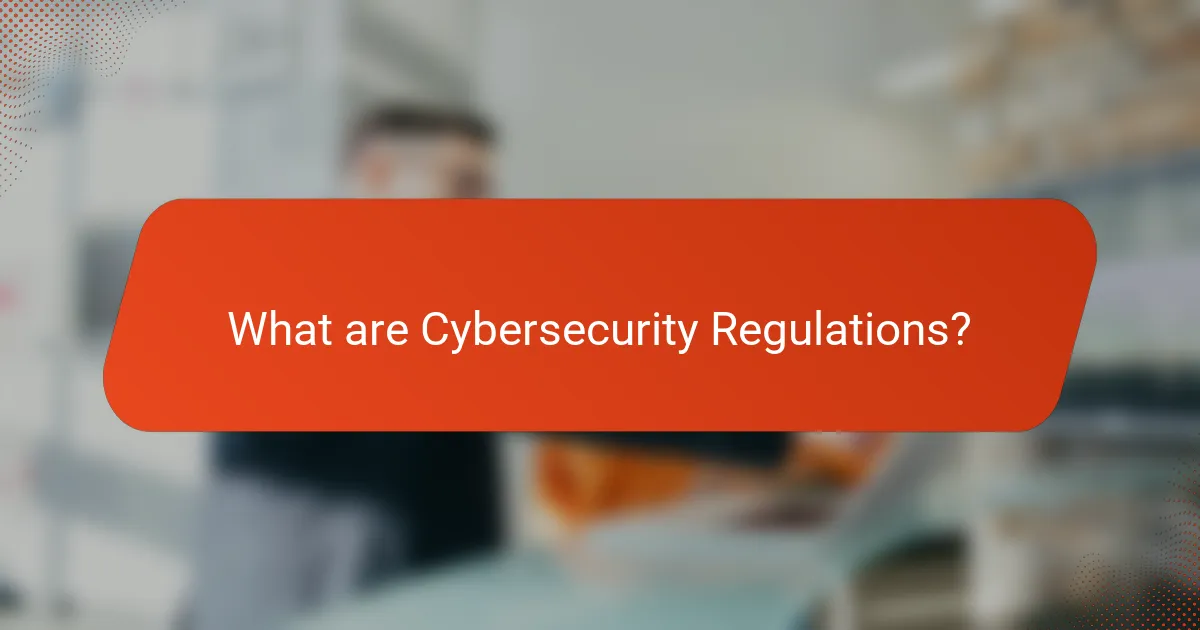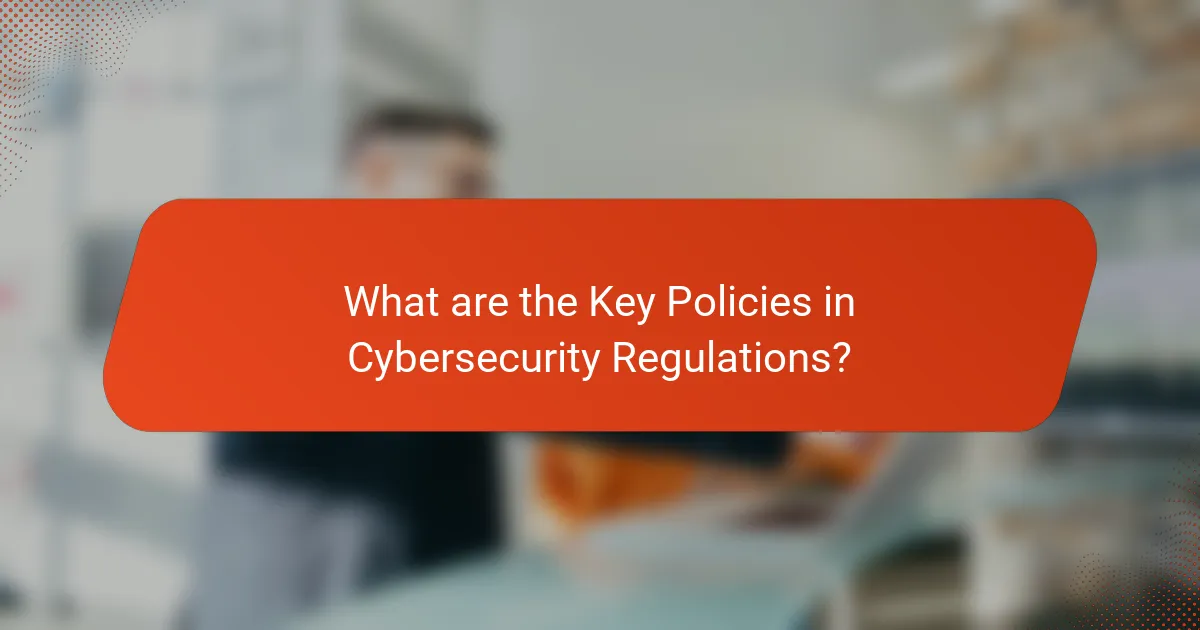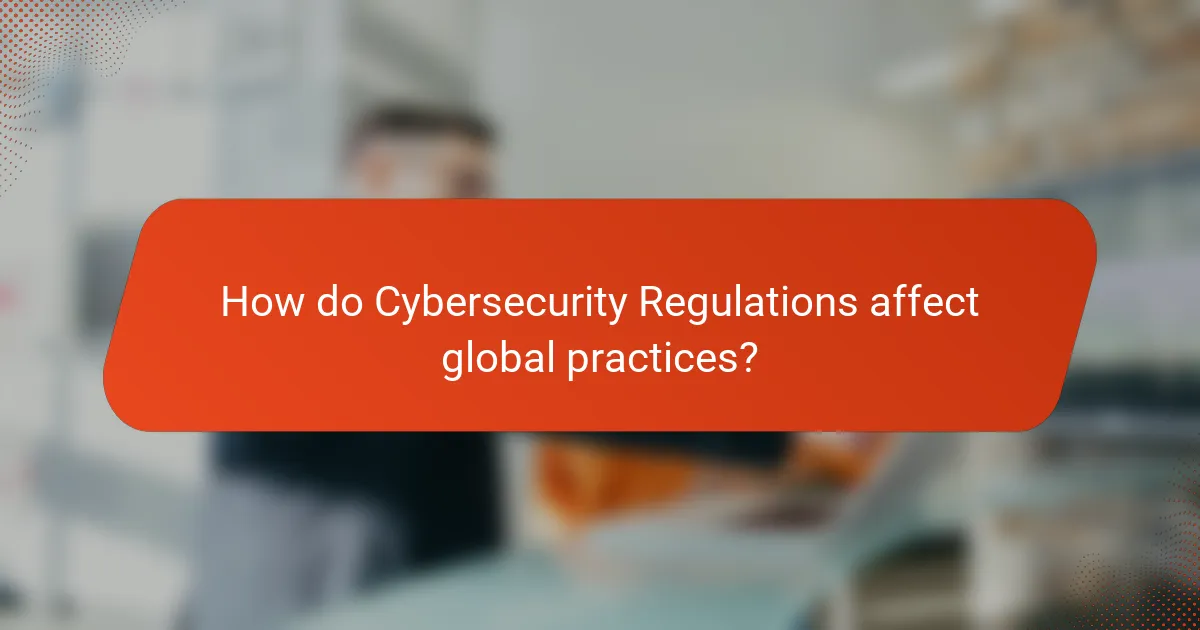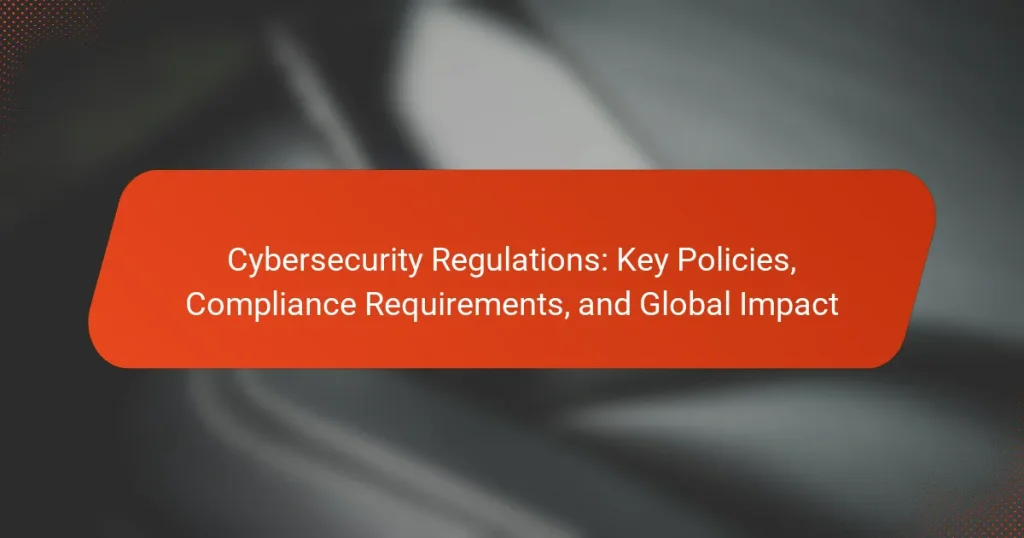Cybersecurity regulations are essential laws and guidelines aimed at protecting sensitive data and information systems from cyber threats. This article covers key policies within these regulations, including data protection, incident response, and risk management, as well as compliance requirements like those outlined in the General Data Protection Regulation (GDPR) and the Health Insurance Portability and Accountability Act (HIPAA). It highlights the significant global impact of these regulations on organizational practices, emphasizing the importance of compliance to enhance security measures and protect consumer privacy. The discussion also addresses the consequences of non-compliance, which can lead to severe penalties and reputational harm for organizations.

What are Cybersecurity Regulations?
Cybersecurity regulations are laws and guidelines designed to protect sensitive data and information systems. They establish standards for organizations to follow in order to safeguard against cyber threats. Examples include the General Data Protection Regulation (GDPR) in Europe and the Health Insurance Portability and Accountability Act (HIPAA) in the United States. These regulations mandate specific security measures, breach notification protocols, and data handling practices. Compliance with these regulations is often enforced through audits and penalties for non-compliance. The objective is to enhance the overall security posture of organizations and protect consumer privacy.
How do Cybersecurity Regulations impact organizations?
Cybersecurity regulations significantly impact organizations by imposing compliance requirements that shape their security practices. These regulations mandate specific data protection measures to safeguard sensitive information. Organizations must allocate resources for training and technology to meet these standards. Non-compliance can lead to substantial fines and legal repercussions. For example, the General Data Protection Regulation (GDPR) enforces strict data handling protocols across the EU. Companies that fail to comply can face fines up to €20 million or 4% of annual global revenue. Additionally, cybersecurity regulations enhance consumer trust by ensuring that organizations prioritize data security. This trust can lead to increased customer loyalty and better market positioning. Overall, regulations drive organizations to adopt robust cybersecurity frameworks, ultimately reducing the risk of data breaches.
What are the primary goals of Cybersecurity Regulations?
The primary goals of Cybersecurity Regulations are to protect sensitive data and ensure system integrity. These regulations aim to prevent unauthorized access to information. They also seek to establish accountability for organizations handling data. Compliance with these regulations helps mitigate risks associated with cyber threats. Additionally, they promote transparency in data handling practices. Regulations often require organizations to implement security measures and conduct regular audits. This framework enhances public trust in digital systems. Overall, these goals contribute to a safer online environment for all users.
How do Cybersecurity Regulations evolve over time?
Cybersecurity regulations evolve over time through a combination of technological advancements, emerging threats, and legislative changes. As technology progresses, new vulnerabilities are identified, prompting updates to existing regulations. For instance, the rise of cloud computing led to the development of specific guidelines for data protection in cloud environments. Additionally, significant cyber incidents often catalyze regulatory changes. The 2017 Equifax breach, which exposed sensitive data of millions, resulted in increased scrutiny and new regulations in data privacy. Stakeholder feedback, including from businesses and security experts, also influences the evolution of these regulations. Furthermore, international collaboration fosters the sharing of best practices, leading to harmonized regulations across borders. Overall, the dynamic nature of the cybersecurity landscape drives continuous adaptation of regulatory frameworks.
Why are Cybersecurity Regulations necessary?
Cybersecurity regulations are necessary to protect sensitive information and maintain public trust. They establish standards for data protection and breach response. Regulations help organizations mitigate risks associated with cyber threats. According to the Ponemon Institute, the average cost of a data breach is $3.86 million. Compliance with regulations can reduce this financial impact. Regulations also ensure accountability among organizations handling personal data. They create a legal framework that holds entities responsible for data security. Without regulations, the likelihood of data breaches and cyberattacks increases significantly.
What risks do Cybersecurity Regulations mitigate?
Cybersecurity regulations mitigate risks such as data breaches, identity theft, and cyberattacks. These regulations enforce standards for data protection and breach notification. They require organizations to implement security measures to safeguard sensitive information. Compliance helps reduce the likelihood of unauthorized access to systems. Regulations also address risks related to non-compliance, which can lead to legal penalties. For example, the GDPR imposes fines for data protection violations. Overall, these regulations create a framework to enhance cybersecurity resilience.
How do Cybersecurity Regulations protect consumer data?
Cybersecurity regulations protect consumer data by establishing legal frameworks that mandate data security measures. These regulations require organizations to implement protocols to safeguard sensitive information. For example, the General Data Protection Regulation (GDPR) enforces strict guidelines on data processing and storage. Organizations must ensure transparency in data collection and obtain user consent. Violations of these regulations can lead to significant fines, incentivizing compliance. Additionally, regulations often require regular security assessments and audits to identify vulnerabilities. Such measures enhance consumer trust in organizations handling their data. Overall, cybersecurity regulations create a structured approach to protecting consumer information from unauthorized access and breaches.

What are the Key Policies in Cybersecurity Regulations?
Key policies in cybersecurity regulations include data protection, incident response, and risk management. Data protection policies mandate organizations to safeguard personal and sensitive information. These regulations often require encryption, access controls, and data minimization practices. Incident response policies establish protocols for addressing cybersecurity breaches. They typically include reporting requirements and steps for containment and recovery. Risk management policies guide organizations in identifying and mitigating cybersecurity risks. This involves regular assessments and updates to security measures. Compliance frameworks, such as GDPR and HIPAA, outline specific requirements for organizations in various sectors. These frameworks help ensure that entities adhere to established cybersecurity standards.
What are the major frameworks for Cybersecurity Regulations?
The major frameworks for Cybersecurity Regulations include the NIST Cybersecurity Framework, ISO/IEC 27001, and the GDPR. The NIST Cybersecurity Framework provides a policy framework of computer security guidance. It is widely adopted in the United States and emphasizes risk management. ISO/IEC 27001 is an international standard for information security management systems. It helps organizations manage sensitive information systematically. The GDPR protects personal data and privacy for individuals within the European Union. It imposes strict data handling and processing regulations. These frameworks guide organizations in achieving compliance and enhancing their cybersecurity posture.
How do these frameworks differ across regions?
Cybersecurity frameworks differ across regions primarily due to varying regulatory requirements and risk landscapes. In North America, frameworks like NIST emphasize risk management and flexibility. In Europe, the GDPR imposes strict data protection and privacy obligations, influencing local cybersecurity practices. Asia-Pacific countries often focus on sector-specific regulations, reflecting diverse economic priorities and technological advancements. For instance, Singapore’s Cybersecurity Act mandates specific security measures for critical sectors. These regional variations highlight differences in legal frameworks, cultural attitudes toward privacy, and the maturity of cybersecurity practices.
What role do international standards play in Cybersecurity Policies?
International standards provide a framework for developing effective cybersecurity policies. They enhance consistency and interoperability across different regions and sectors. These standards help organizations identify and manage cybersecurity risks systematically. They also promote best practices and guidelines that improve overall security posture. For instance, the ISO/IEC 27001 standard outlines requirements for establishing, implementing, and maintaining an information security management system. This standard is recognized globally and aids organizations in achieving compliance with various regulations. Additionally, international standards facilitate collaboration and information sharing among nations and organizations. This collaboration is crucial for addressing cross-border cybersecurity threats effectively.
What compliance requirements must organizations meet?
Organizations must meet various compliance requirements to ensure cybersecurity. These include regulations such as the General Data Protection Regulation (GDPR), which mandates data protection and privacy for individuals in the EU. Another key requirement is the Health Insurance Portability and Accountability Act (HIPAA), which sets standards for protecting sensitive patient information in the healthcare sector. Additionally, organizations must adhere to the Payment Card Industry Data Security Standard (PCI DSS) for handling credit card information securely. Compliance with the Federal Information Security Management Act (FISMA) is also essential for federal agencies and their contractors. Non-compliance can lead to significant penalties, including fines and legal action. Each of these regulations aims to protect sensitive data and maintain user trust in digital systems.
How do compliance requirements vary by industry?
Compliance requirements vary significantly by industry due to differing regulatory frameworks and risk profiles. For example, the healthcare industry must comply with HIPAA, which mandates strict patient data protection measures. In contrast, the financial sector is governed by regulations like GLBA and PCI DSS, focusing on safeguarding financial information. The technology sector faces compliance with GDPR, emphasizing data privacy and user consent. Each industry has unique attributes influencing its compliance landscape. These attributes include the nature of data handled, potential risks, and specific legal obligations. Therefore, understanding these differences is crucial for effective compliance strategies.
What are the consequences of non-compliance with Cybersecurity Regulations?
Non-compliance with cybersecurity regulations can lead to severe consequences. Organizations may face substantial fines and penalties. For instance, the General Data Protection Regulation (GDPR) can impose fines up to €20 million or 4% of annual global revenue. Additionally, non-compliance can result in reputational damage. Companies may lose customer trust and face public backlash. Legal actions may also arise from affected parties. This can lead to costly lawsuits and settlements. Furthermore, non-compliance increases vulnerability to cyberattacks. Organizations may lack necessary protections, leading to data breaches. Overall, the consequences are significant and multifaceted, impacting both financial and operational aspects of a business.

How do Cybersecurity Regulations affect global practices?
Cybersecurity regulations significantly influence global practices by establishing standards for data protection and risk management. These regulations create a framework that organizations must follow to safeguard sensitive information. Compliance with these regulations often leads to improved security measures and protocols. For instance, the General Data Protection Regulation (GDPR) has set a high standard for data privacy in Europe. Organizations worldwide are adopting similar practices to meet these standards. Non-compliance can result in hefty fines and reputational damage. This encourages businesses to prioritize cybersecurity in their operations. As a result, global practices are increasingly aligned with regulatory requirements, enhancing overall cybersecurity resilience.
What is the global impact of Cybersecurity Regulations?
Cybersecurity regulations have a significant global impact on data protection and privacy. They establish frameworks that organizations must follow to secure sensitive information. Compliance with these regulations can enhance consumer trust in digital services. For instance, the General Data Protection Regulation (GDPR) in Europe has influenced privacy laws worldwide. Companies face penalties for non-compliance, which encourages adherence to security standards. Additionally, these regulations promote international cooperation in combating cybercrime. They also drive innovation in cybersecurity technologies and practices. Overall, cybersecurity regulations shape the landscape of global digital security and privacy.
How do Cybersecurity Regulations influence international trade?
Cybersecurity regulations influence international trade by establishing compliance standards for data protection. These regulations require businesses to implement security measures that protect sensitive information. Non-compliance can lead to penalties and restrictions on market access. For example, the General Data Protection Regulation (GDPR) in the European Union mandates strict data handling practices. Companies outside the EU must comply to trade with EU nations. Additionally, cybersecurity regulations can affect supply chain relationships. Firms may choose partners based on their compliance status. This creates a competitive landscape where adherence to regulations becomes crucial for market participation. Furthermore, regulations help build consumer trust, which is essential for cross-border transactions. According to a 2020 report by the World Economic Forum, strong cybersecurity measures can enhance trade by reducing risks related to data breaches.
What challenges do organizations face in complying with global regulations?
Organizations face several challenges in complying with global regulations. These challenges include differing regulatory standards across regions. Organizations must navigate complex legal frameworks that vary widely. Inconsistencies in data protection laws can lead to compliance difficulties. Additionally, organizations often struggle with resource allocation for compliance efforts. The lack of standardization in compliance requirements increases operational costs. Organizations also face challenges in keeping up with evolving regulations. Rapid technological advancements can outpace regulatory updates. Furthermore, inadequate training for employees can lead to non-compliance risks. These factors collectively hinder effective compliance with global regulations.
What best practices should organizations follow for compliance?
Organizations should follow best practices for compliance by implementing a robust cybersecurity framework. This includes regularly assessing risks and vulnerabilities. Organizations must also establish clear policies and procedures for data protection. Training employees on compliance requirements is essential. Regular audits and monitoring help ensure adherence to regulations. Organizations should stay updated on relevant laws and regulations. Documenting compliance efforts provides accountability and transparency. Engaging with legal and cybersecurity experts can enhance compliance strategies.
How can organizations effectively implement Cybersecurity Policies?
Organizations can effectively implement Cybersecurity Policies by establishing clear guidelines and protocols. They should conduct a thorough risk assessment to identify vulnerabilities. Training employees on these policies is essential for compliance and awareness. Regular audits can help ensure adherence to the established policies. Organizations must also update their policies to reflect evolving threats. Utilizing cybersecurity frameworks, such as NIST or ISO, provides a structured approach. Engaging stakeholders in policy development fosters a culture of security. Statistics indicate that organizations with comprehensive cybersecurity training reduce incidents by up to 70%.
What resources are available for understanding Cybersecurity Regulations?
Resources available for understanding Cybersecurity Regulations include government websites, industry publications, and academic research. The National Institute of Standards and Technology (NIST) provides guidelines and frameworks. The Cybersecurity and Infrastructure Security Agency (CISA) offers resources on compliance and best practices. Additionally, organizations like ISACA and (ISC)² publish reports and white papers on cybersecurity policies. Online courses and webinars from platforms like Coursera and edX also cover regulatory requirements. Academic journals such as the Journal of Cybersecurity provide peer-reviewed articles on the latest research in the field.
Cybersecurity regulations are laws and guidelines aimed at protecting sensitive data and information systems from cyber threats. This article outlines key policies associated with cybersecurity regulations, compliance requirements across various industries, and the global impact these regulations have on data protection and privacy. It discusses the evolution of regulations, the risks they mitigate, and the consequences of non-compliance, while also highlighting major frameworks like GDPR and NIST. Additionally, the article addresses challenges organizations face in adhering to these regulations and best practices for effective implementation of cybersecurity policies.



